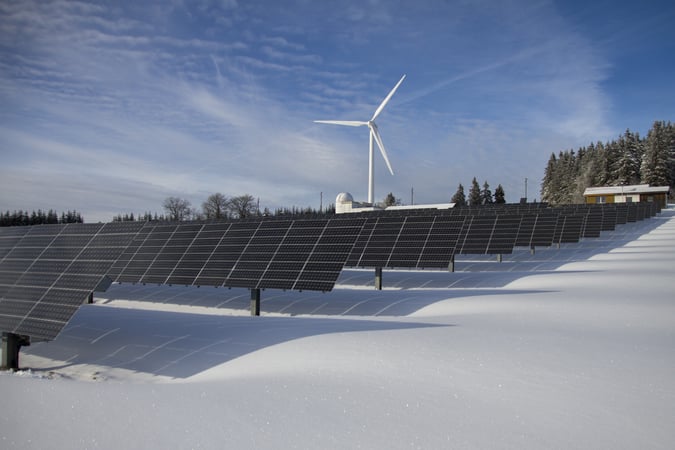Here at KSV, we are fluent in energy. We speak it, our clients speak it; we are energy nerds. So, what happens when we need to talk energy to non-nerds?
Well, that’s exactly what we’ve been doing for over 40 years. We embed ourselves in the energy industry and conduct in-depth consumer research. It’s the combination of these two disciplines that makes us able to effectively convey complex energy technologies and strategies to typical customers.
Over the past year, we have written articles on electric vehicles (EVs), wind energy, and beneficial electrification as emerging technologies worth communicating to your customers. Today, we are covering a new topic: energy storage.
The viability of energy storage has hit a tipping point that will make all the above-mentioned technologies live up to their full potential, and it is time to start telling your customers about it.
There are two contexts where we see energy storage coming to life:
Storage as a way to help meet ambitious 80 x 50 goals (reducing greenhouse gas emissions 80% by 2050) that many states, municipalities, and utilities have committed to.
Many customers are already engaged in the battle against climate change, and messaging around climate impact goals resonates well with them.
As a beacon for innovative energy and aggressive climate goals, the Massachusetts Department of Public Utilities has issued two orders to address net metering and capacity ownership that lay the groundwork for nation-leading storage goals. These fundamental changes will encourage more innovation and grow local jobs while driving toward these targets.
New York is certainly not one to be outdone when it comes to aggressive climate goals, and their approach to storage is equally bold. They have laid a framework for ambitious state objectives and utility mandates, as well as easing the introduction of storage into the market.
Electrified transportation is part of every plan to address climate change. Edison Electric projects that 18.7 million EVs will be on the road by 2030. However, the burden that this technology could place on the grid is significant and requires regulators and states to look at EV value from every angle. Specifically, utilities are seeing the potential of using vehicle batteries to power the grid during times of need. This means that our individual vehicles could become grid resources and consumers could participate in supplying the grid just as a solar developer can. Utilities should integrate battery storage into the conversation when communicating the many benefits of electric vehicles.
Storage as a way for utilities and energy-intensive businesses to add greater flexibility and resiliency to their existing generation mix.
When storms hits or disaster strikes, customers will take comfort in understanding not only how their utility is able to serve them, but why they are able to do so—i.e., a strong, resilient grid. Capitalize on accountability and ability to provide service in times of need by incorporating memorable messaging about energy storage into your communications with customers.
Here are a few notable examples of utilities and energy companies focusing on energy storage as a way to both improve the grid and overall business performance:
- Green Mountain Power continues to lead in pilot programs and has one of the most mature residential storage programs, featuring Tesla Powerwalls and functioning as a virtual power plant. In the summer of 2018, Green Mountain Power was able to save over $500,000 during a one-week heat wave thanks to this program.
- During Puerto Rico’s post-hurricane recovery, hospitals and critical services were able to rebound by using solar and storage resources, allowing them to come back much more quickly than the areas of the U.S. island that were limited to traditional grid resources for backup.
- Recently, our friends at Schneider Electric demonstrated for us their Energy Solutions platform, which allows complete “islanding” from the grid in the event of outages (or perhaps increasing utility rates). They can alternate and adjust their power mix between solar, battery, and EV batteries, and power their critical operations with complete disconnection from the grid.

Energy storage makes it possible for renewable energy sources such as wind & solar to provide energy to consumers, 24/7.
How do we communicate these ideas to consumers?
We know that sun doesn’t shine when it’s storming, the wind doesn’t always blow, and EVs will cause new and potentially unprecedented demand spikes. If you want a steady supply of electricity and a resilient grid for all, no matter what the circumstances, renewable energy generation strategies can’t meet your needs without the capability to store excess energy for rainy days, windless weather, or extreme demand spikes.
While we agree that communicating this is not an easy task, we have also done so countless times with other emerging energy technologies. We have found the recipe for success. We are in the field right now, gaining insights from consumers. What do they already know about energy storage? How could energy storage impact them? What would motivate them to embrace energy storage? How would they like to learn more about energy storage?
We can’t wait to share what we’ve learned, and one thing is key: involve customers in conversations about complex energy technologies—like energy storage—right from the beginning. Ensure they can own and contribute to the conversation, and the messaging that follows will be much more meaningful.
Want to learn more about communicating energy storage and other emerging energy technologies to your customers? Give us a call or send us an email today!
